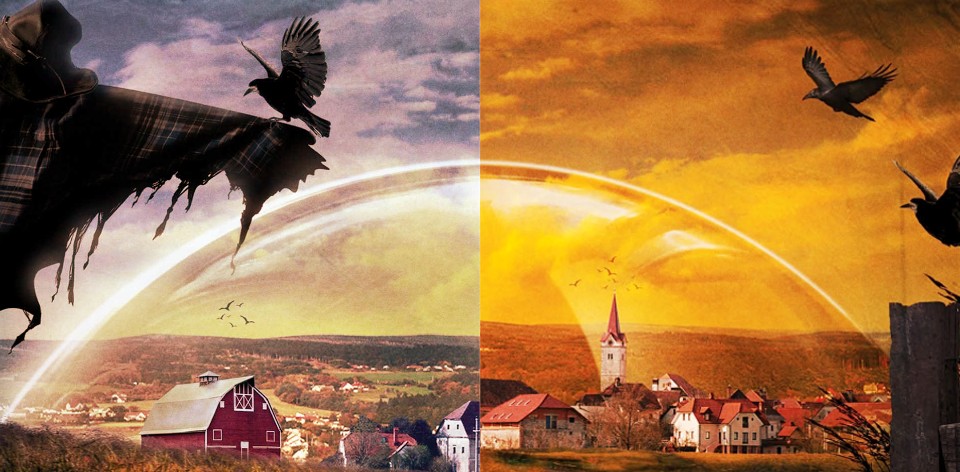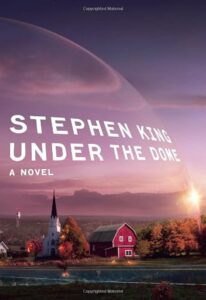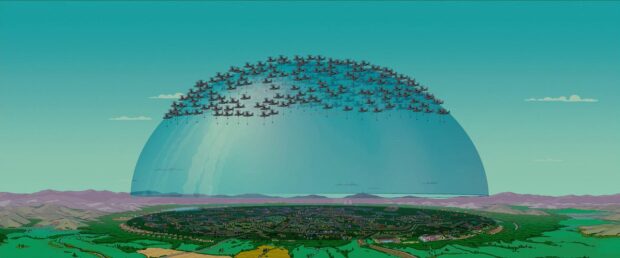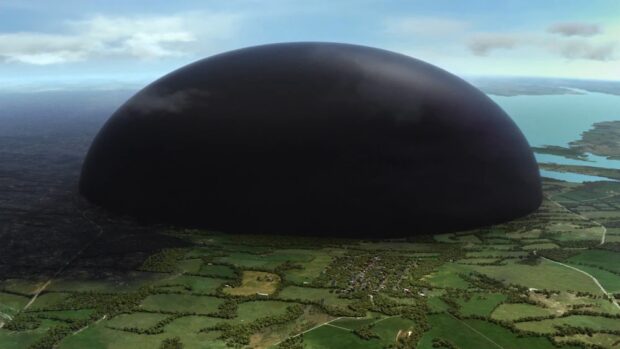Welcome back to Inconstant Reader, the inconstant feature column that explores Stephen King’s books in the order they were published — sort of! Warning: lift the lid of this dome and you’ll uncover some major SPOILERS.
The Simpsons did it first.
That was always the gag. No matter what scenario you create in pop culture, The Simpsons got there first. In The Simpsons Movie (2007), the Environmental Protection Agency (EPA) imprisoned Springfield under a giant glass dome.
So, when UNDER THE DOME was published in 2009, many were quick to point out the similarities between that film and the plot of the movie and King’s novel. Some cried foul. Yet the truth is not as clear-cut as all that. King had actually been playing with the idea since the late 1970s with the unpublished and unfinished novel The Cannibals, originally titled (you guessed it) Under the Dome. (King, for the records, claims to have not heard of The Simpsons Movie plot at the time of publication and we can probably put it down to one of those happy coincidences).
Even people who haven’t read UNDER THE DOME, or seen the TV series of the same name, know what it is about. It’s become a bit of an odd-bird of a pop cultural touchstone, the kind that feels more like a setup to a punchline at times.
Which is probably the mood that King wanted us Constant Readers to be in when we first cracked open this massive satire of life in post-9/11 America. In the fictional town of Chester’s Mill, somewhere in King’s Maine Literary Universe, the titular dome has descended over the town. Nobody knows how or why, but by gorry they will try to get out.
There is an understandable urge to compare this to The Stand. While King has a reputation for doorstop-sized literature, there’s really only a handful of his tomes that truly live up to that reputation. UNDER THE DOME certainly has the length and breadth of the chunkier entries. So, if The Stand is a book that looks at how the world changed through the lens of a handful, then this is the opposite: how a small town changed when it was cut off from the rest of the world. In this sense, it is more akin to the novella The Mist.
This is because UNDER THE DOME sets itself up as something of a microcosm. There’s jocks, bigots, military, religious extremists, the press, the switched-on youth (and the tuned-out), meth addicts, drug kingpins, throwback hippies, victims, and perpetrators. There are hints throughout of the source of the Dome, with people speculating everything from terrorism to extraterrestrials. (More on that later!) Yet the real focus is on these humans interacting under the most extreme of conditions, like so many ants in a farm.
Perhaps more than any book King has written in this vein, he seems to revel in the more repulsive instincts of human nature. The book begins with a double homicide, and later necrophilia from an unhinged fellow with a brain tumour. There’s a gang rape scene that King returns to in detail more than once. When you think he’s moved on from it, another female character is sexually assaulted. At one point I wanted to call back in time and check up on 2009 Stephen to see if he was okay. At others, I just felt numbed by the relentlessness of it, as if King was caught under his own little dome while writing.
At well over 1,000 pages, King can devote time to exploring character-laden plot and vice versa. Yet I have to admit that there were points where I lost the thread of one character’s journey, or got to a point where I simply didn’t care enough about any of these solipsistic maneuvers in the dark. Like Needful Things or even ‘Salem’s Lot, King works incredibly well when he is dissecting small town minutiae. Placed under glass, all of those wicked inner thoughts are magnified for better or for worse.
Of course, all of this is simply so that King can pull the rug out from under us in the final act. This is where the book kicks into high gear in a gripping climax. As chaos rips through the town, any connections we have made are tested, and preconceived notions of justice and comeuppance are thrown out the window. The origins of the Dome and its makers are almost an afterthought — think: a petit version of The Tommyknockers or Dreamcatcher thrown in for good measure — as those things matter to the town as little as they should to the reader. (Of course, they do matter to us, and one can’t help but feel a little robbed after such a long a setup).
Cut to 2023, and domes are everywhere. Even Shazam: Fury of the Gods has borrowed from this book’s ending as well. Indeed, it’s interesting reading this book on this side of the current pandemic. Where most pundits referenced King’s plague book during the 2020/2021 lockdowns, not least of which was due to a TV adaptation emerging at the time, UNDER THE DOME probably came closer to how humans actually acted during an isolating crisis. A sense of community gave way to a rebellion against the measures in some camps, while becoming politically divisive in other camps. In King’s book, the majority of the town dies in an accident. In our world, WHO estimates 6.8 million deaths since 2020 and counting. If there’s a parallel, it’s to say our collective response was mixed to poor.
UNDER THE DOME arguably represents something of a turning point in King’s oeuvre. At some point in the last decade or so, his work became more politically charged. In Cell and this book we see references to the legacy of the Bush administration. In this book, we have a snapshot of how King viewed America at the time. In more recent novels, and on his Twitter feed, he has levelled his finger at the Republican Party and their most recent US President. If we want to know who the players would be in the 2023 equivalent, just follow King on social media.
When Constant Reader returns, it will be with the short story anthology Full Dark, No Stars. There will be no partial dark and some stars. Likewise, the lights will not be on in any form. Full dark. Stars nil.







